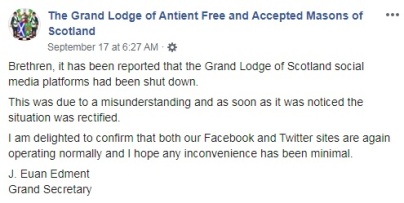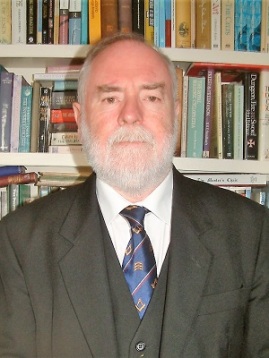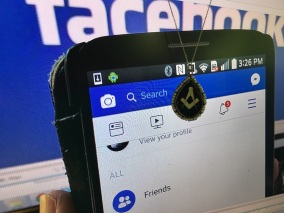By Karen Kidd, PM
(I speak only for me)
“The more rapid the change, the more substantial must be the response. In light of this, it is perhaps inappropriate for Freemasonry to seek to be immune to E-communication if its essential values are to survive.”
– Gerald Reilly and Josh Heller, “The Temple That Never Sleeps” (Cornerstone Book Publishers, 2006)
Back in September, the world – or at least those who paid attention – watched as the Grand Lodge of Scotland briefly rejected social media, in part because the so-called “secrets” were leaking out.
It was an abrupt about face by the grand lodge, which had for years enthusiastically embraced Facebook, Twitter and other social media platforms, in addition to its excellent website that provides informative announcements, articles and photos.
FULL DISCLOSURE: I am a huge fan of Robert Cooper, curator of the grand lodge’s library and museum, and editor of its Twitter and Facebook pages, in addition to being a noted Freemasonic historian, scholar and writer.
Cooper had the very awkward task of explaining to the wider world, via the Times in London (the Times online sits behind a pay wall, so I’ll quote with wild abandon), why the grand lodge’s social media pages had been put on hold pending an internal review.
“As with any organization there are internal private discussions that shouldn’t be aired in public,” Cooper was quoted in the Times. “Unfortunately, some of our members are doing that. Naively, they are putting up messages on Facebook saying, ‘What do you think about what the Grand Lodge are proposing?’ Issues being discussed are not public but then, all of sudden, they are in the public domain.”
Members also had been outing other members without consent and “there also have been cases where online disputes between brothers became less than fraternal,” Cooper was quoted in the Times.
The withdrawal didn’t go unnoticed.
“We have got 25,000 people from around the world who read the posts regularly,” Cooper was quoted in the Times. “We have had lots of queries as to why we have stopped.”
Yeah, well, it didn’t last. The Grand Lodge of Scotland quickly re-embraced social media and then tried to put the debacle behind them.
 “Brethren, it has been reported that the Grand Lodge of Scotland social media platforms had been shut down,” Grand Lodge of Scotland Grand Secretary J. Euan Edment said in a statement issued two days after the Times article was published. “This was due to a misunderstanding and as soon as it was noticed the situation was rectified. I am delighted to confirm that both our Facebook and Twitter sites are again operating normally and I hope any inconvenience has been minimal.”
“Brethren, it has been reported that the Grand Lodge of Scotland social media platforms had been shut down,” Grand Lodge of Scotland Grand Secretary J. Euan Edment said in a statement issued two days after the Times article was published. “This was due to a misunderstanding and as soon as it was noticed the situation was rectified. I am delighted to confirm that both our Facebook and Twitter sites are again operating normally and I hope any inconvenience has been minimal.”
The “inconvenience” resulted from only the latest effort by Freemasonic grand lodges and other supreme bodies to grapple with the pros and cons of life in the Internet Age and rise of the “E-Mason.”

Gerald Reilly
The E-Mason, as Gerald Reilly and Josh Heller observed in their book “The Temple That Never Sleeps,” published more than a decade ago, is “a Freemason for whom a part, at least, of their Masonic improvement is provided by membership of a Masonic E-group, or groups, set up for and subscribed to, for that purpose.”
When Reilly and Heller wrote that definition, Facebook was still in its infancy and most E-Masons were active in online Masonic forums (my personal favorite – and, gods how I miss it! – was “The Three Pillars”). In those online forums, Freemasons of all types were free to get to know each other, exchange ideas and generally communicate unfettered on the interwebs.
Those online forums have largely disappeared, replaced by Reddit and other social media platforms, but the unfettered communication continues.
While all of that has been going on, the grand lodges and other supreme bodies have largely viewed the cross-jurisdictional communication between individual Freemasons with no little worry. Those same bodies also have simultaneously tried to figure out how to harness the myriad of opportunities provided by the Internet.
“Technological innovation has radically changed the conduct of our daily lives. We can do things faster, easier and cheaper than ever before. We have information at our fingertips and an ability to communicate with each other, around the globe at the speed of light.” – Reilly and Heller, “The Temple That Never Sleeps”
Freemasonry has always – ALWAYS – been open to technological advances in the larger world and has been more than happy to adapt them to Masonic life and jurisdictional practice. Those advances have allowed members to travel further afield to attend meetings and functions while communication advances helped strengthen bonds between Masonic bodies and created other bonds that previously did not exist.
It isn’t all about being in walking distance and sending letters by courier anymore. Freemasonry has advanced along with the rest of the world.
So, why is the Internet so different?
There’s no simple answer to that question but I’ll try to keep it simple, notwithstanding.
Quite frankly, Freemasonic grand lodges and other supreme bodies have harnessed the Internet for the benefits that can be reaped but, like the Grand Lodge of Scotland, they’re still puzzling out some serious downsides.
First, the pros: The Internet makes it easier for Brothers and Sisters to communicate and communication is the gateway to understanding.
Second, the cons: The Internet makes it easier for Brothers and Sisters to communicate and communication is the gateway to understanding.
Grand lodges and other supreme bodies appreciate the Internet as a vehicle for making their front offices function more smoothly and be accessible. This translates internally into greater vehicles for getting information to their membership and externally into greater visibility for would-be members to find them.
It’s no longer a know-one-to-be-one situation. Those who seek Freemasonry now have a far easier time finding orders most congenial to them.
This development has been of especial importance to co- and femalecraft Freemasonry that in decades past had a very difficult time surviving, thanks in no small part to persistent persecution by the more numerous malecraft. The Internet has leveled the field for all three branches and made persecution far more difficult to carry out unnoticed.
Greater understanding between individual brothers and sisters, made all the more possible by the Internet, also has sharply reduced desire for continued persecution and increased interest in pursuing avenues of mutual interest.
The Internet also, for better or otherwise, gave rise to orders based entirely in the Internet. For me, that’s a bridge too far. An entirely virtual lodge experience would not work for me; I am more of an orthodox, traditional, brick-and-mortar Freemason.
However, I also am a great proponent of choice in Freemasonry. If virtual Masonry is your thing, have at it. The Internet made that possible for you.
More than making Freemasonry easier to find, there also is the not-unappreciated value of the Internet as a means of presenting a good image to the public. Bad things can happen when the public collectively decides that Freemasonry is bad. The Internet makes it easier for Freemasonic bodies to let the larger world know that they’re good people.
Faced with the great need to maintain good public relations, grand lodges and other supreme bodies find it unhelpful when individual members do or advocate unMasonic things or otherwise don’t toe the Masonic line. Those bodies are ever anxious that the world at large understand that their individual members speak only for themselves, not for the order to which they belong.
That distinction often is lost on the wider world.
Which is why the actions of misbehaving members is an even greater problem than before the Internet Age. Such misbehavior is now more easily noticed by the wider world (the William Morgan incident not excluded) and can reflect poorly on the order(s) to which the misbehaving brother(s) belong(s). Good public relations are important to the front office, particularly in areas where Freemasonry is under attack, so errant members are a huge concern.
It likewise is no especial shock that grand lodges and other Masonic supreme bodies don’t appreciate the Internet when it’s used by individual members to counter the various Masonic lines that those bodies promulgate. It also is now much more difficult for those bodies to reel in the errant brother or sister who doesn’t toe the Masonic line; or worse, doesn’t respect that line or doesn’t know that the line exists.
Those bodies also have been wary of the Internet as the medium by which Freemasons of various ilks – including bodies not in amity with each other and between whom there has been disharmony – to meet in a more level way. On the one hand, the Internet is helpful in providing greater opportunities for education and for brothers and sisters to get to know each other.
It also helps break down artificial barriers based on “regularity” and “amity,” which is where the wariness comes in. Regularity and amity are very much front office concerns and individual members might be less than sensitive to those concerns. They might, in fact, disagree and say so online – in the public domain.
However, the issue that seems to attract the most attention, as we saw with the Grand Lodge of Scotland in September, is individual members being too loose with an order’s secrets.
The Internet certainly has made Freemasonry’s so-called “secrets” more available but hasn’t made especially clear – for the Internet is generally a murky, if information dense, place – that the secrets aren’t about being secret. It’s about Freemasons being disciplined enough to not reveal them.
It’s about the individual Freemason, not the secrets.
So far as Freemasonic grand lodges and other Masonic supreme bodies are concerned, it’s one thing for the secrets to be available via more shadowy portions of the Internet; but quite another for their own members to share them on social media.
All of these issues are only the tip of the iceberg of what the various Masonic bodies are trying to figure out as they sail even further into the Internet Age. Some are maneuvering through those dangerous waters with more grace than others.
As we saw, the Grand Lodge of Scotland briefly tried the draconian approach, which magnificently failed. The failures attract far more attention than do the successes.
If you’ve read this far and are expecting me to suggest what the Grand Lodge of Scotland should have done or to provide an easy solution to all of this, I am going to disappoint you. I have no idea.
I, like everyone else in this Internet Age, am hoping for the very best but am anxious about what may turn out to be the very worst.
I do know that, barring something catastrophic that forces us all to dramatically regress in our collective evolution, the Internet, social media and E-Masonry aren’t going away. Fool that I am, I remain optimistic.
As Reilly and Heller observed more than a decade ago about the Temple that never sleeps:
“E-Masonry may well be met with challenges, obstacles and resistance along the way although we are not aware of any degree of formal resistance or for any proscription of participation. Perhaps it should be regarded as something that is future proof and that it could aid the survival of Freemasonry’s traditional values, although perhaps not in a traditional format.”

